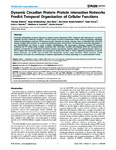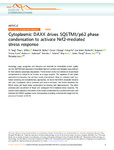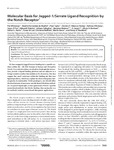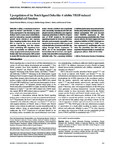Dynamic Circadian Protein–Protein Interaction Networks Predict Temporal Organization of Cellular Functions

Date
2013Author
Subject
Metadata
Show full item recordAbstract
Essentially all biological processes depend on protein-protein interactions (PPIs). Timing of such interactions is crucial for regulatory function. Although circadian (~24-hour) clocks constitute fundamental cellular timing mechanisms regulating important physiological processes, PPI dynamics on this timescale are largely unknown. Here, we identified 109 novel PPIs among circadian clock proteins via a yeast-two-hybrid approach. Among them, the interaction of protein phosphatase 1 and CLOCK/BMAL1 was found to result in BMAL1 destabilization. We constructed a dynamic circadian PPI network predicting the PPI timing using circadian expression data. Systematic circadian phenotyping (RNAi and overexpression) suggests a crucial role for components involved in dynamic interactions. Systems analysis of a global dynamic network in liver revealed that interacting proteins are expressed at similar times likely to restrict regulatory interactions to specific phases. Moreover, we predict that circadian PPIs dynamically connect many important cellular processes (signal transduction, cell cycle, etc.) contributing to temporal organization of cellular physiology in an unprecedented manner.
Collections
Publisher
Place of Publication
Journal
Volume
Issue
Pagination
Author URL
Number
Recommended, similar items
The following license files are associated with this item:
Related items
Showing items related by title, author, creator and subject.
-
Cytoplasmic DAXX drives SQSTM1/p62 phase condensation to activate Nrf2-mediated stress response
Yang, Y; Willis, TL; Button, RW; Strang, CJ; Fu, Y; Wen, X; Grayson, PRC; Evans, T; Sipthorpe, RJ; Roberts, SL; Hu, Bing; Zhang, J; Lu, B; Luo, Shouqing (Springer Science and Business Media LLCEngland, 2019-08-21)<jats:title>Abstract</jats:title><jats:p>Autophagy cargo recognition and clearance are essential for intracellular protein quality control. SQSTM1/p62 sequesters intracellular aberrant proteins and mediates cargo delivery ... -
Molecular basis for Jagged-1/Serrate ligand recognition by the Notch receptor.
Whiteman, P; de Madrid, BH; Taylor, P; Li, D; Heslop, R; Viticheep, N; Tan, JZ; Shimizu, H; Callaghan, J; Masiero, M; Li, JL; Banham, AH; Harris, AL; Lea, SM; Redfield, C; Baron, M; Handford, PA (United States, 2013-03-08)We have mapped a Jagged/Serrate-binding site to specific residues within the 12th EGF domain of human and Drosophila Notch. Two critical residues, involved in a hydrophobic interaction, provide a ligand-binding platform ... -
Up-regulation of the Notch ligand Delta-like 4 inhibits VEGF-induced endothelial cell function.
Williams, CK; Li, J-L; Murga, M; Harris, AL; Tosato, G (United States, 2006-02-01)Delta-like 4 (Dll4), a membrane-bound ligand for Notch1 and Notch4, is selectively expressed in the developing endothelium and in some tumor endothelium, and it is induced by vascular endothelial growth factor (VEGF)-A ...




